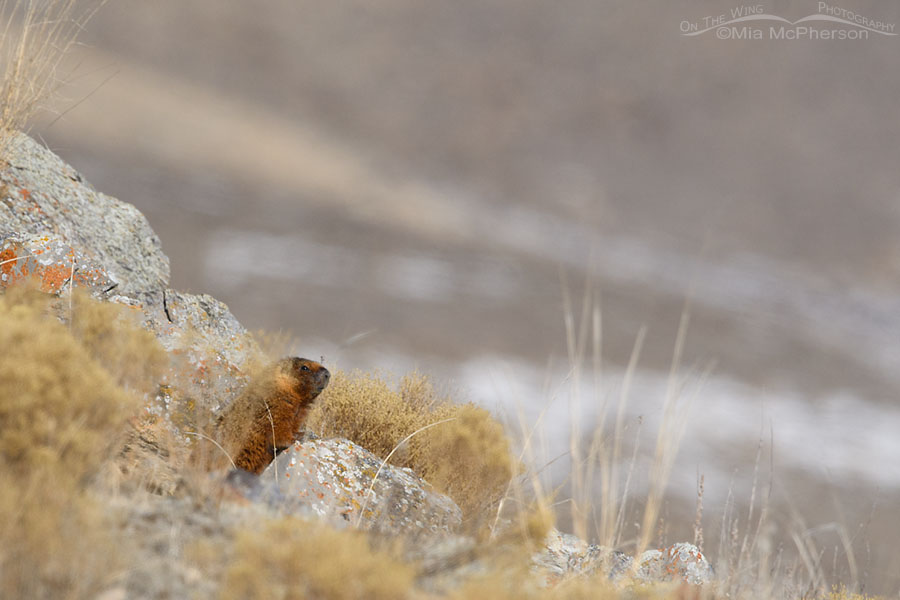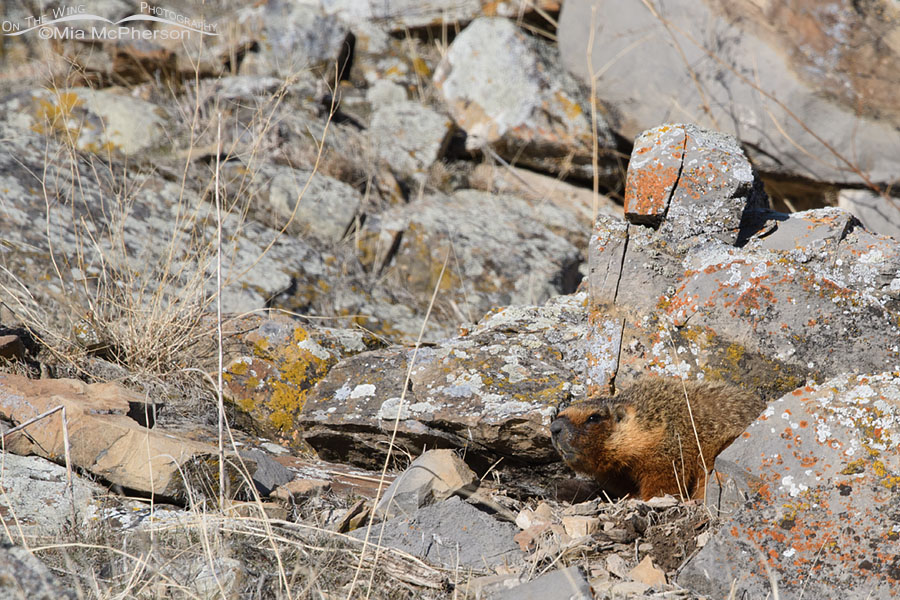 Yellow-bellied Marmot on a rocky slope in February – Nikon D500, f7.1, 1/3200, ISO 640, Nikkor 500mm VR with 1.4x TC, natural light
Yellow-bellied Marmot on a rocky slope in February – Nikon D500, f7.1, 1/3200, ISO 640, Nikkor 500mm VR with 1.4x TC, natural light
The Yellow-bellied Marmot in these photos should be hibernating until mid-March. I spotted it wide awake yesterday on a rocky slope in northern Utah. Typically I start seeing Yellow-bellied Marmots around the middle of March at lower elevations so finding this male wide awake was quite a surprise for me.
I may have seen two individual marmots yesterday. I saw one closer to the road but I wasn’t able to photograph it. While I was waiting to see if that marmot would pop back up on the top of the rocks when I saw the marmot that is in these photos. I can’t say with any certainty that the marmot in my photos is or isn’t the first one I found.
April Olson also found a Yellow-bellied Marmot awake and above the ground yesterday at Bear River Migratory Bird Refuge which is many miles away from where I found the one in my images.
 Yellow-bellied Marmot above ground way too early in winter – Nikon D500, f7.1, 1/3200, ISO 640, Nikkor 500mm VR with 1.4x TC, natural light
Yellow-bellied Marmot above ground way too early in winter – Nikon D500, f7.1, 1/3200, ISO 640, Nikkor 500mm VR with 1.4x TC, natural light
We have had a warmer than normal winter in Salt Lake City where the temperature reached the mid 50’s the day before I found this marmot and they reached that high yesterday too. The temps where I photographed the marmot I found yesterday average slightly lower due to its more northerly latitude.
I don’t know if our marmots in northern Utah are coming out of hibernation early because of our warmer than normal temps, if it is because they are hungry, or if they are awake because they are ill. It might even be a combination of any of those three causes. What I do know is that it isn’t normal at all to see these marmots above the ground in early February even at the lower elevations of northern Utah. Our marmots should be in their hibernating in their burrows.
Life is good. Confusing at times, but good.
Mia
Click here to see more of my Yellow-bellied Marmot photos plus facts and information about this species.


Sorry I did not try for a photo of the marmot at BRMBR. It was a bit further than my lens can capture. If you are out that way let me know I will tell you the area I saw it. You could probably get a decent photo with a 500mm.
I live in north central Washington state near the Canadian border. We had one of the mildest Januarys I can remember, but we’ve got 3 nights with single digit lows coming starting tomorrow night. Hope that cold doesn’t seep down your way if the critters are already coming out of hibernation!
We’ve had a warmer-than-usual winter in CA as well and with little precipitation. I dread an early spring because that means an early — and long and hot — summer.
H! Sweetie!
It is sunny here in Va. Wind is cold! I saw the first Robins Today! This is way too early, Have a great day
I suspect that Liz is right. Which is sad and bad. I would delight in seeing these beauties though.
Maybe the Yellow-bellied Marmot is in tune with the American Robins. We are seeing flocks and flocks of robins in early February where we don’t usually see them until early March. I know you want more snow because of drought but I’m guessing it means an early spring. A definite sign of climate change.
Thanks for posting this! The Great Backyard Bird Count is starting soon… should we have a Great Marmot Count too?https://www.birdcount.org/